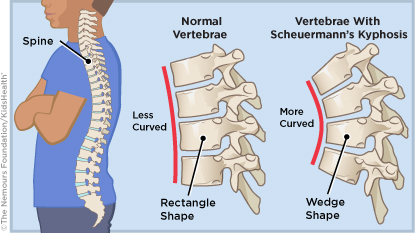Scheuermann's kyphosis (kye-FOH-sis) happens when the bones in the upper back (vertebrae) are shaped like wedges or triangles instead of rectangles. It causes a rounded or hunched back that can sometimes cause pain. Care for Scheuermann's kyphosis is important while kids and teens are growing. After they're done growing, the curve doesn't usually get worse and the pain gets better.




Your child:

What causes Scheuermann's kyphosis? The exact cause of Scheuermann's kyphosis isn't known, but it can run in families. It usually happens in kids who are 10–12 years old and is more common in boys than girls.
Does Scheuermann's kyphosis cause back pain? Kids with Scheuermann's kyphosis can have back pain. When they stop growing, the pain usually improves. Sometimes, though, symptoms last into adulthood.
How is Scheuermann's kyphosis treated? Treatment depends on whether a child is in pain, how much their spine is curved, and the stage of their growth. Some kids might only need pain relief and stretching/strengthening exercises. Others may need to wear a brace. Sometimes, surgery is recommended.